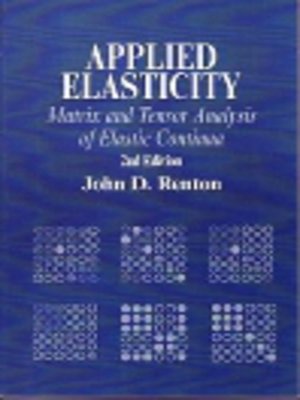Applied Elasticity
ebook ∣ Matrix and Tensor Analysis of Elastic Continua · Woodhead Publishing Series in Civil and Structural Engineering
By J D Renton

Sign up to save your library
With an OverDrive account, you can save your favorite libraries for at-a-glance information about availability. Find out more about OverDrive accounts.
Find this title in Libby, the library reading app by OverDrive.



Search for a digital library with this title
Title found at these libraries:
| Library Name | Distance |
|---|---|
| Loading... |
This updated version covers the considerable work on research and development to determine elastic properties of materials undertaken since the first edition of 1987. It emphasises 3-dimensional elasticity, concisely covering this important subject studied in most universities by filling the gap between a mathematical and the engineering approach. Based on the author's extensive research experience, it reflects the need for more sophisticated methods of elastic analysis than is usually taught at undergraduate level. The subject is presented at the level of sophistication for engineers with mathematical knowledge and those familiar with matrices. Readers wary of tensor notation will find help in the opening chapter. As his text progresses, the author uses Cartesian tensors to develop the theory of thermoelasticity, the theory of generalised plane stress, and complex variable analysis. Relatively inaccessible material with important applications receives special attention, e.g. Russian work on anisotropic materials, the technique of thermal imaging of strain, and an analysis of the San Andreas fault. Tensor equations are given in straightforward notation to provide a physical grounding and assist comprehension, and there are useful tables for the solution of problems.
- Covers the considerable work on research and development to determine elastic properties of materials undertaken since the first edition of 1987
- Emphasises 3-dimensional elasticity and fills the gap between a mathematical and engineering approach
- Uses Cartesian tensors to develop the theory of thermoelasticity, the theory of generalised plane stress, and complex variable analysis







